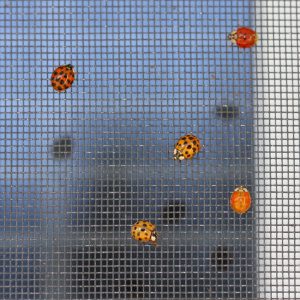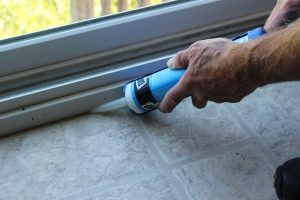Originally published on March 24, 2018 – Courtesy of Paul Hetzler, CCE St. Lawrence County

Pest management used to be a lot simpler, and more effective. For those bothersome vampire problems you had your basic wooden stakes, cheap and readily available. The well-to-do could afford silver bullets, an elegant and tidier solution. And of course, garlic was the solution to prevent repeat infestations. These days many people are asking where to find teeny silver bullets for Asian multicolor lady-beetles, because they are a real problem this winter.
On sunny fall days, the Asian multicolored lady-beetle, Harmonia axyridis, often hangs out with its pals on west or south-facing walls. The insect may be beneficial for gardens and harmless to us, but as winter approaches, these insects quit swarming to seek shelter in outbuildings, wall cavities, firewood piles and other nooks and crannies. Eventually, some of them find their way inside our homes. I don’t know what the sanctioned collective noun is for a gathering of Harmonia axyridis, but it should be a drove, since they can be enough to drive you out of the house.
From what I can tell, the orange-and-black ladybug, darling of small children everywhere, first arrived in the U.S. — at our invitation — in about 1916, as a control for aphids on pecan trees and other crops. Adorable lady-beetles didn’t turn into ogres until the mid-1990s. There is evidence to suggest the current population might be a strain accidentally released at the Port of New Orleans in the late 1980s or early 1990s. Whatever their origin, these new lady-beetles are here to stay.
Asian multicolored lady-beetles don’t carry disease, damage structures, suck blood or sting, and they eat harmful agricultural pests. More importantly, they do not breed indoors. However, they stain, give off a foul odor when disturbed and will even pinch one’s skin on occasion. It’s their sheer numbers, though, amassing in corners of garages and porches, coating the insides of picture windows, which unnerves and bugs us.

Managing ladybugs, it turns out, can cut your heating bill. They are looking for someplace rent-free and cozy to spend the winter, and as warm air leaks out here and there from your house, they follow it to its source and let themselves in. Caulking around windows, vents and where cable or other utilities come through the wall, and between the foundation and sill, will help immensely with lady-beetle control, and somewhat with reducing drafts. It is also helpful to ensure that door sweeps/thresholds are tight, and check for cracked seals around garage doors. Installing screens on attic vents and inspecting all window screens is in order as well.
It’s best to avoid swatting or crushing them because they will release a smelly, staining yellow defense fluid. For a variety of reasons including the ladybugs’ habit of seeking inaccessible areas, indoor pesticides are practically useless against them. Spraying inside is strongly discouraged. Instead, use a broom and dustpan to knock them down and then suck them up with a vacuum cleaner or shop-vac.

You can make a reusable “mini-bag” out of a knee-high nylon stocking inserted into the hose of a canister-type vacuum. Secure it on the outside with a rubber band and hang onto it as you clean up the bugs. Just remember to quickly empty it into a pail of soapy water (gas or kero is hazardous and unnecessary).
Unfortunately, there is no easy way to combat multicolored Asian lady-beetles once they are inside — we have to persevere and vacuum and sweep them out for now. Home improvements this summer will help prevent repeat bug visits. I have no doubt that it must be more satisfying to dispatch vampires in one easy step than to fight endless lady-beetles, but I would bet it is a lot more dangerous, too.
Contact Paul Hetzler of Cornell Cooperative Extension of St. Lawrence County at ph59@cornell.edu.
For more information on multicolored asian lady beetle, brown marmorated stink bugs, boxelder bugs, and other occasional invaders, check out How to deal with occasional invaders on the New York State Integrated Pest Management Program’s What’s Bugging You? page.